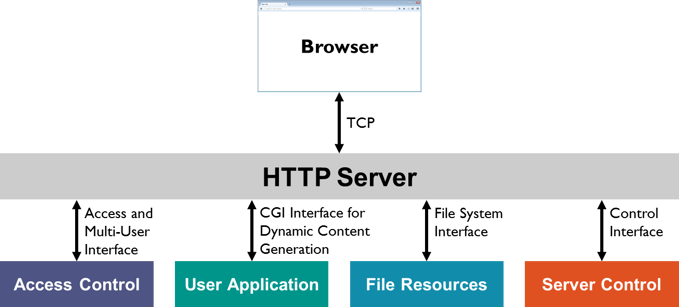 |
Network Component
Version 7.19.0
MDK Middleware for IPv4 and IPv6 Networking
|
 |
Network Component
Version 7.19.0
MDK Middleware for IPv4 and IPv6 Networking
|
HTTP Web Server routines are used to run and configure services of the embedded web server. More...
Content | |
| Dynamic Web Content | |
| Advanced Web Technologies for modern Web-based User Interfaces. | |
| Delivering Web Pages | |
| How web pages are stored on and delivered by the HTTP Server. | |
| Control Interface | |
| Functions to work with the HTTP server. | |
| Access and Multi-User Interface | |
| Functions to filter access to the HTTP server and to work with user accounts. | |
| File System Interface | |
| HTTP server functions that work with a File System. | |
| Common Gateway Interface (CGI) | |
| Functions reacting on CGI requests to the HTTP server. | |
| Configuration | |
| Configuration of the HTTP server in µVision. | |
| FCARM File Converter | |
| Software utility to compile static web pages. | |
HTTP Web Server routines are used to run and configure services of the embedded web server.
A HTTP or web server processes requests via HTTP, a network protocol used to exchange information on the World Wide Web (WWW). The main function of a HTTP server is to store, process and deliver web pages to clients. Pages delivered are usually HTML documents, which may include images, style sheets and scripts in addition to text content. Using HTML, you describe what a page must look like, what types of fonts to use, what color the text should be, where paragraph marks must come, and many more aspects of the document.
Using SSL/TLS, you can securely communicate with the web server through HTTPS. The ARM mbed TLS software component enables this for the Network component's web server. Refer to Secure Communication for more information.
There are two types of web pages which are stored on a web server and sent to a web client on request:
The Network Component supports both of them. Static web pages are generally stored in a ROM file system. The files are converted into C-code by the FCARM file converter and compiled into code.
The Network Component supports two types of HTTP servers: the Compact Web Server can store HTML files only in a read-only memory (ROM). An update of pages stored in ROM is not possible. The Full Web Server uses the to store data on a rewritable storage device. These files can be updated in the field. Several advanced features are integrated into both web servers:

This documentation is separated as follows: